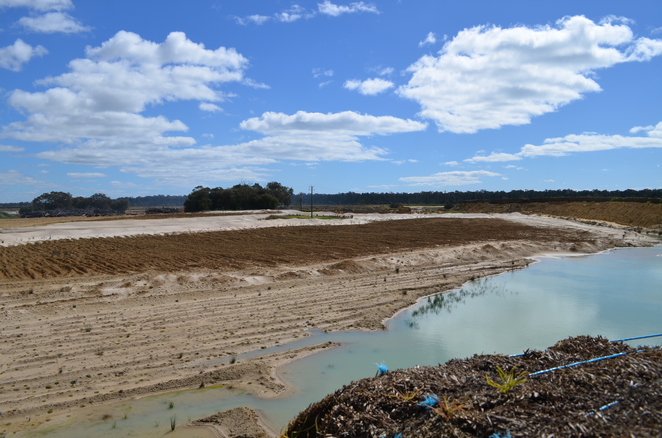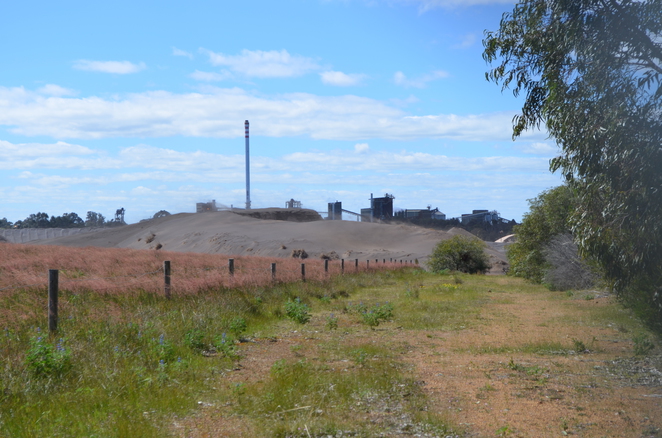Capel mineral sands mines, Capel Shire, Western Australia, Australia
| Latitude & Longitude (WGS84): | 33° 33' 22'' South , 115° 34' 9'' East |
|---|---|
| Latitude & Longitude (decimal): | -33.55619,115.56927 |
Australia is the worlds largest rutile and zircon mineral sands producer, and second largest for ilmenite sands. The company presently controlling the Capel Mines (who also mine mineral sands at Eneabba) is Iluka Resources, the worlds largest producer of zircon, and titanium dioxide products of rutile.
Mines generally form two north-south bands. One follows closely the main highway from Bunbury to Busselton, with the Wonnerup Mine just north of Busselton to mines and the processing plant just north of Capel. Another band follows the base of the Darling Scarp from inland of Busselton to just south of Boyanup. Over 20 deposits are known. Several mines have come and gone, and been rehabilitated, while several more appear to be active at the same time. Mine names include Wonnerup and Wonnerup South just north of Busselton, Higgins just south of Capel, Capel just north of the town, while inland are Yoganup, Yonganup Extended, Yoganup Extended North and Gwindingup. This list is not complete.
Mining commenced in 1956 at the Yoganup deposit by Westralian Sands Ltd, with five further mines opened over the subsequent ten years. Yoganup Extended started in 1971, Yoganup North 1987. The Yoganup deposits contain ilmenite, rutile, leucoxene, zircon and monazite. Associated Minerals Consolidated, and Cable Sands (WA) Pty Ltd historically mined the western section near the highway and Capel town, in younger palaeo Quartenary shorelines of the Safety Bay Sands, and Bassendean Sand.
Iluka was formed in July 1988 through the merger of Westralian Sands and Renison Goldfields Limited, and came to control the whole field.
The Yoganup Formation is a siliciclastic deposit, probably pleiocene in age, laid along palaeo shorelines during a period of elevated sea levels. The heavy mineral bearing sands were deposited by wave, wind and current action into a series of shoreline placer deposits. A typical deposit has seven shoreline sequences, up to 4.5 kilometres long, with individual strands up to 400 metres wide, and to a depth of 20 metres.
Lithography varies, but a typical example is (1) basal feldspathic sandstones,(2)over this a conglomerate 10-30 cms thick of quartzite gravels and boulders; (3)then a clay free coarse grained sand with low heavy minerals; (4)then a 20 cm thick fine to medium grained sands displaying small scale ripples and cross stratification structures;
(5)next a high heavy mineral 3 metre thick layer with up to 95% heavy minerals; (6)in some places a bioturbated zone one metre thick; (7)
then broad scale cross stratified dunal sand up to 10 metres thick,
(8)with 5-10 cm clay cap.
Generally rutile, zircon and alumina silicates are lower in the Capel area, than the Eneabba mines found north of Perth. Circulating acidic groundwater is responsible for the leucoxenisation of the ilmenite. Feldspars have been completely converted to kaolin clay. Mineral sand deposits in Western Australia are by their nature usually specimen free zones, unless of course you collect sand.
Map- highlights the town of Capel, but mines are north, south and east of the town.
Mineral List
5 valid minerals.
Rock Types Recorded
Select Rock List Type
Alphabetical List Tree DiagramRegional Geology
This geological map and associated information on rock units at or nearby to the coordinates given for this locality is based on relatively small scale geological maps provided by various national Geological Surveys. This does not necessarily represent the complete geology at this locality but it gives a background for the region in which it is found.
Click on geological units on the map for more information. Click here to view full-screen map on Macrostrat.org
| Pleistocene 0.0117 - 2.588 Ma | Guildford Formation Age: Pleistocene (0.0117 - 2.588 Ma) Stratigraphic Name: Guildford Formation Description: Alluvial sand and clay with shallow-marine and estuarine lenses and local basal conglomerate. Comments: regolith; synthesis of multiple published descriptions Lithology: Regolith Reference: Raymond, O.L., Liu, S., Gallagher, R., Zhang, W., Highet, L.M. Surface Geology of Australia 1:1 million scale dataset 2012 edition. Commonwealth of Australia (Geoscience Australia). [5] |
Data and map coding provided by Macrostrat.org, used under Creative Commons Attribution 4.0 License







Capel mineral sands mines, Capel Shire, Western Australia, Australia